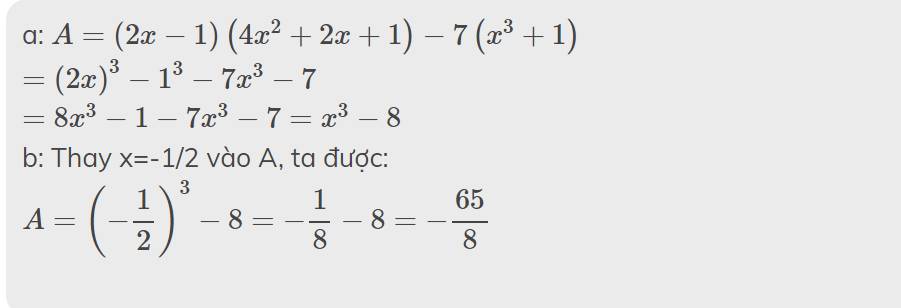Hãy nhập câu hỏi của bạn vào đây, nếu là tài khoản VIP, bạn sẽ được ưu tiên trả lời.

Bài 1:
a) x≠2
Bài 2:
a) x≠0;x≠5
b) x2−10x+25x2−5x=(x−5)2x(x−5)=x−5x
c) Để phân thức có giá trị nguyên thì x−5x phải có giá trị nguyên.
=> x=−5
Bài 3:
a) (x+12x−2+3x2−1−x+32x+2)⋅(4x2−45)
=(x+12(x−1)+3(x−1)(x+1)−x+32(x+1))⋅2(2x2−2)5
=(x+1)2+6−(x−1)(x+3)2(x−1)(x+1)⋅2⋅2(x2−1)5
=(x+1)2+6−(x2+3x−x−3)(x−1)(x+1)⋅2(x−1)(x+1)5
=[(x+1)2+6−(x2+2x−3)]⋅25
=[(x+1)2+6−x2−2x+3]⋅25
=[(x+1)2+9−x2−2x]⋅25
=2(x+1)25+185−25x2−45x
=2(x2+2x+1)5+185−25x2−45x
=2x2+4x+25+185−25x2−45x
=2x2+4x+2+185−25x2−45x
=2x2+4x+205−25x2−45x
c) tự làm, đkxđ: x≠1;x≠−1

Do \(x^2+1\ge1>0;\forall x\)
\(\Rightarrow\dfrac{3x-2}{x^2+1}>0\Leftrightarrow3x-2>0\)
\(\Leftrightarrow3x>2\)
\(\Leftrightarrow x>\dfrac{2}{3}\)


a: \(A=\left(2x-1\right)\left(4x^2+2x+1\right)-7\left(x^3+1\right)\)
\(=\left(2x\right)^3-1^3-7x^3-7\)
\(=8x^3-1-7x^3-7=x^3-8\)
b: Thay x=-1/2 vào A, ta được:
\(A=\left(-\dfrac{1}{2}\right)^3-8=-\dfrac{1}{8}-8=-\dfrac{65}{8}\)


c: \(A=x^3-8=\left(x-2\right)\left(x^2+2x+4\right)\)
Để A là số nguyên tố thì x-2=1
=>x=3